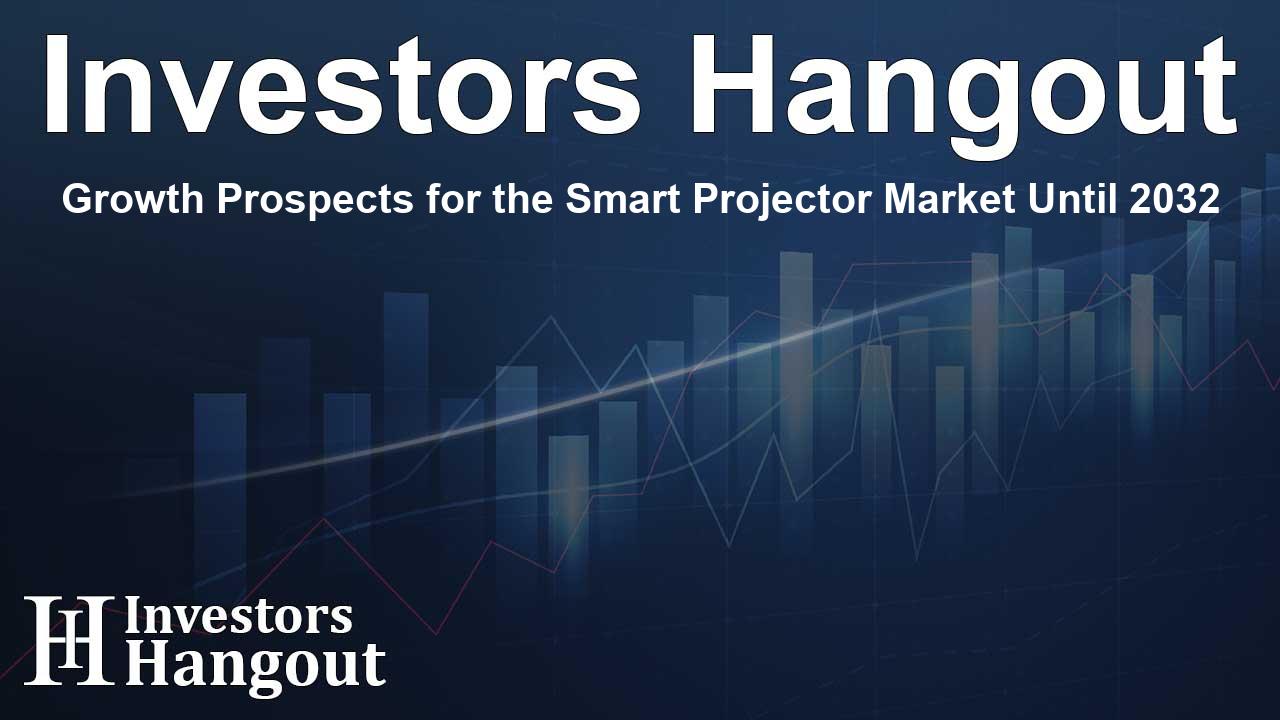Growth Prospects for the Smart Projector Market Until 2032

Exploring the Booming Smart Projector Market
The smart projector market is experiencing remarkable growth, driven by technological advancements and increasing consumer demand. This market, which was valued at approximately USD 2.47 billion recently, is projected to soar past USD 10.72 billion within a few years. The anticipated compound annual growth rate (CAGR) of 17.7% from 2024 to 2032 signifies a vibrant and robust trend towards smart projection technologies.
Understanding Smart Projectors
At their core, smart projectors are portable devices that integrate computing capabilities and smart connectivity features. They eliminate the need for external streaming devices by supporting Bluetooth, Wi-Fi, and HDMI connections. Users can enjoy resolutions ranging from Full HD to 4K, and many devices incorporate voice control and app integration for a seamless experience. This mix of portability, advanced features, and user-friendliness is propelling their adoption across various sectors.
Commercial Demand Surge
Businesses are increasingly seeking smart projectors to enhance their presentations and meetings. The modern workspace demands tools that promote efficient communication. Smart projectors facilitate wireless connectivity and interactivity, making them essential for dynamic collaboration. As more companies shift towards tech-driven environments, the integration of smart projectors into corporate settings has escalated significantly. This shift underscores the importance of visual technologies that meet the operational goals of efficiency.
Challenges Posed by High-End Pricing
Despite the positive growth trajectory, the high cost of premium smart projectors remains a challenge. While advanced features such as 4K resolution and laser technology enhance functionality, they also lead to increased manufacturing costs. This results in a limited market largely accessible to tech enthusiasts and professional environments. Consequently, budget-sensitive consumers and small businesses may find themselves excluded from adopting these innovative solutions.
Technological Innovations Shaping the Market
Innovation in projector technology is vital for meeting diverse consumer needs and preferences. The rise of 3D capabilities poses significant opportunities, not just for entertainment but also for various professional applications. From immersive home theater experiences to the expansion of 3D visual requirements in fields like architecture and engineering, these features can attract tech-savvy audiences. As industries seek enhanced visualization tools, the introduction of seamless 3D compatibility in projectors positions brands favorably within a competitive market landscape.
Connectivity Challenges
While connectivity is a primary feature of smart projectors, it can also be a source of frustration. Many smart projectors depend on stable Wi-Fi connections and compatibility with popular streaming services. However, users often face issues due to regional restrictions and software incompatibilities. These challenges can compromise the overall user experience, leading to elements like lag and connectivity drops. To address these hurdles, manufacturers must focus on improving compatibility and reliability across different platforms.
Key Players in the Smart Projector Industry
The smart projector market comprises several influential companies dedicated to advancing projector technology. Notable names include Dell, Christie Digital Systems, ViewSonic, and HP. Each of these companies is actively enhancing their product offerings, focusing on innovation and customer satisfaction. For instance, Dell is pushing boundaries with advanced display technologies while Christie Digital Systems contributes significantly to high-end projection solutions.
Recent Product Developments
Innovation continues among leading brands, as evidenced by several recent product launches. For instance, ViewSonic introduced its M1 Pro portable projector, which offers unique 360° projection capabilities. Similarly, in late 2023, Sony unveiled its latest laser projectors designed specifically for educational and corporate use, enhancing visual quality and functionality. These advancements reflect an ongoing commitment to providing cutting-edge solutions that meet evolving consumer expectations.
Regional Insights and Future Trends
The Asia Pacific region is expected to dominate the smart projector market, buoyed by rapid technological innovation and strong manufacturing capabilities. Countries like China, Japan, and South Korea are at the forefront of developing smart projectors that meet varying consumer demands. This region’s strong emphasis on research and development combined with cost-effective production ensures a favorable balance of quality and affordability, catering to a global audience.
Conclusion and Industry Outlook
In conclusion, the smart projector market is on an exciting growth trajectory fueled by a convergence of technological innovations and shifting consumer demands. While challenges such as high pricing and connectivity issues remain prevalent, the potential for market expansion through new technological integrations like 3D projection is substantial. As major companies innovate and refine their product offerings, we can expect a bright future for smart projectors as indispensable tools across both residential and commercial sectors.
Frequently Asked Questions
What is the projected growth rate for the smart projector market?
The smart projector market is expected to grow at a CAGR of 17.7% from 2024 to 2032.
What are the main applications for smart projectors?
Smart projectors are primarily used in commercial settings for presentations and meetings, as well as in home entertainment setups.
What technologies are driving innovation in smart projectors?
Key technologies driving innovation include 3D compatibility, high-resolution output, and improved connectivity features.
How does the pricing of smart projectors affect adoption?
High prices of advanced smart projectors can restrict their accessibility to budget-conscious consumers and small businesses.
Which companies are leading the smart projector market?
Major players in the smart projector market include Dell, Christie Digital Systems, ViewSonic, and HP.
About The Author
Contact Lucas Young privately here. Or send an email with ATTN: Lucas Young as the subject to contact@investorshangout.com.
About Investors Hangout
Investors Hangout is a leading online stock forum for financial discussion and learning, offering a wide range of free tools and resources. It draws in traders of all levels, who exchange market knowledge, investigate trading tactics, and keep an eye on industry developments in real time. Featuring financial articles, stock message boards, quotes, charts, company profiles, and live news updates. Through cooperative learning and a wealth of informational resources, it helps users from novices creating their first portfolios to experts honing their techniques. Join Investors Hangout today: https://investorshangout.com/
The content of this article is based on factual, publicly available information and does not represent legal, financial, or investment advice. Investors Hangout does not offer financial advice, and the author is not a licensed financial advisor. Consult a qualified advisor before making any financial or investment decisions based on this article. This article should not be considered advice to purchase, sell, or hold any securities or other investments. If any of the material provided here is inaccurate, please contact us for corrections.
